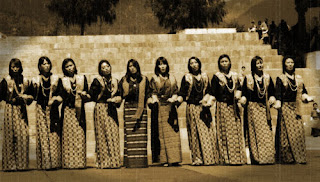Zhungdra:
dying voice of the divine
MAIN SOTRY: It was 1968. A group of veteran Bhutanese
singers and instrumentalists boarded a plane for the first time. They were to
make a gramophone recording upon the command of the Third Druk Gyalpo Jigme
Dorji Wangchuck. It was the peak of summer in Calcutta, India. They travelled
to the Dum Dum Studio and started recording. Among the group were Aup Dawpey
and Aum Thinlem. They made two trips that year, each lasting for about 20 days.
Aup
Dawpey
Aup Dawpey was 37 and
played both limand drangyen(Bhutanese lute). While
Aum Thinlem, then just 20, sang her heart out.
The group recorded 15 tracks. Most of the
numbers were Zhungdra. The songs recorded at the studio were released on a
long-playing vinyl record, which were distributed to Bhutanese royals and
officials.
Dasho Drupon, who played drangyen, led the group with Drimpon
Sonam Dorji, a respected dance instructor and vocalist. In addition to Drimpon
Sonam Dorji, male vocalists included Bumtap Tawla, Nija Kado and Goen Tawchu.
Female vocalists included Tshewang Lham, Aum Thinlem, Changzam Dagom and Ani
Lham.
The group also included
instrumentalists Khetu who played chiwang, Dawpay who played drangyenand flute, Tango Pem
Namgay who played drangyen and Gyelwa Karamapas Drapa played flute.
The records slowly disappeared into oblivion
until it was rediscovered by the Music of Bhutan Research Centre (MBRC), after
more than four decades.
MBRC obtained a copy of the records, identified
as 33PIX.1017, from a close attendant of the Third King, Dasho Sangay Tenzin.
The
veteran singers presented with the 1968’s Gramophone Recordings
The 1968’s Gramophone Recordings was launched in
Thimphu last week, which brought fresh memories to Aup Dawpey and Aum Thinlem.
They relived those days, once more, through the songs.
“I felt like I was brought to life from the
death when I heard those songs again. I remember every moment and I have
nothing but good memories,” Aum Thinlem said.
Aup Dawpay lamented about how Zhungdra has lost
its charm over the years.
“Zhungdra was popular when I was growing up. It
was sacred and a precious opportunity if one got a chance to perform in front
of a crowd,” Aup Dawpay said. “Today, I feel sad that this traditional music is
dying out with the older generation.”
History
Zhungdra is the oldest style of traditional
Bhutanese folk music. It is distinguished by the way it is sung using extended
vocal tones in complex patterns. Singers and dancers form a long line and hold
hands when they sing the song. They move in a slow, synchronised order,
following the lyrics of the music. Dancers always face towards lama. Zhungdras were composed by spiritual leaders and contain spiritual
messages.
“Zhungdra is considered
as a sacred song (jinlab
chen gi zhabdra),”. “True Zhungdra consists of 13 songs, performed only once during the
Punakha dromchoe along with the masked dances.”
It was first performed in the 17th century to
commemorate the victories over the Tibetans. It was performed as a gesture of
appreciation to the protective deities Yeshey Gonpo and Pelden Lhamo.
Zhungdra is performed
as a Lui Choepa,
an offering of the body and soul, to the protective deities,” he said. “Out of
the 13 songs, the shortest Zhungdra is the Drubai Puna Dechen.
However, people fail to identify the real
Zhungdra and consider any lengthy song as a Zhungdra. Zhungdra became popular
from the time of Second King’s, but it was allowed to be performed only during
the Punakha dromchoe. However, during the Third King’s time, the
rules were relaxed and Zhungdra was performed during other occasions as well.
If people are
interested to learn Zhungdra, there are people who can teach. “But I fear it’s
too late. We already lost the opportunity and the time to relive these musical
genre, which was so fiercely guarded by our elders.” With changing times, music genre like Zhungdra is lost. Like dzongs, which we can’t replicate today, we
can’t grasp or keep a hold on Zhungdra. Zhungdra is an ancient tradition, only
to change with changing times. Today, there are only about five real Zhungdra
singers left in the country.
With digitalisation, the taste in music is also
changing. There are only a few audiences who like to Zhungdra today. Change is
inevitable. Zhungdra is dying without a patronage, market, appeal
and presence to the present generation.The slow death of Zhungdra is both positive and
negative. We can’t play Zhungdra in the streets and bars.
It’s a devotional song composed by trulkus and lamas. It has a direct impact on
spiritual being.
Challenges
Learning Zhungdra takes a lot of time because
one has to understand the meaning of every word, which many are not able to do
so. Lyrics are complicated and words unreadable. Today we are living in a fast-paced world with
fast-paced music. Many hardly have time to sit and listen to a slow song such
like Zhungdra and understand the lyrics. The true
essence of Zhungdra is lost in the midst of oral transmissions. It changes with
the change in dance movements, songs and lyrics.
It’s difficult to preserve Zhungdra without
proper archival and documentation. Zhungdra is not meant for entertainment
purposes and has thus lost its value among the commercially-driven music
industry. Today, music is only meant for entertainment
purposes and thus Zhungdra has lost its authentic, aesthetical and traditional
value.



Comments
Post a Comment
comment and help me to go further